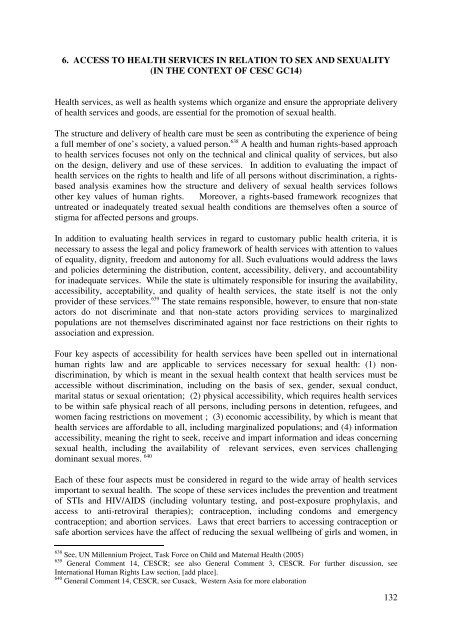SEXUAL HEALTH AND HUMAN RIGHTS A legal and ... - The ICHRP
SEXUAL HEALTH AND HUMAN RIGHTS A legal and ... - The ICHRP
SEXUAL HEALTH AND HUMAN RIGHTS A legal and ... - The ICHRP
You also want an ePaper? Increase the reach of your titles
YUMPU automatically turns print PDFs into web optimized ePapers that Google loves.
6. ACCESS TO <strong>HEALTH</strong> SERVICES IN RELATION TO SEX <strong>AND</strong> <strong>SEXUAL</strong>ITY<br />
(IN THE CONTEXT OF CESC GC14)<br />
Health services, as well as health systems which organize <strong>and</strong> ensure the appropriate delivery<br />
of health services <strong>and</strong> goods, are essential for the promotion of sexual health.<br />
<strong>The</strong> structure <strong>and</strong> delivery of health care must be seen as contributing the experience of being<br />
a full member of one’s society, a valued person. 638 A health <strong>and</strong> human rights-based approach<br />
to health services focuses not only on the technical <strong>and</strong> clinical quality of services, but also<br />
on the design, delivery <strong>and</strong> use of these services. In addition to evaluating the impact of<br />
health services on the rights to health <strong>and</strong> life of all persons without discrimination, a rightsbased<br />
analysis examines how the structure <strong>and</strong> delivery of sexual health services follows<br />
other key values of human rights. Moreover, a rights-based framework recognizes that<br />
untreated or inadequately treated sexual health conditions are themselves often a source of<br />
stigma for affected persons <strong>and</strong> groups.<br />
In addition to evaluating health services in regard to customary public health criteria, it is<br />
necessary to assess the <strong>legal</strong> <strong>and</strong> policy framework of health services with attention to values<br />
of equality, dignity, freedom <strong>and</strong> autonomy for all. Such evaluations would address the laws<br />
<strong>and</strong> policies determining the distribution, content, accessibility, delivery, <strong>and</strong> accountability<br />
for inadequate services. While the state is ultimately responsible for insuring the availability,<br />
accessibility, acceptability, <strong>and</strong> quality of health services, the state itself is not the only<br />
provider of these services. 639 <strong>The</strong> state remains responsible, however, to ensure that non-state<br />
actors do not discriminate <strong>and</strong> that non-state actors providing services to marginalized<br />
populations are not themselves discriminated against nor face restrictions on their rights to<br />
association <strong>and</strong> expression.<br />
Four key aspects of accessibility for health services have been spelled out in international<br />
human rights law <strong>and</strong> are applicable to services necessary for sexual health: (1) nondiscrimination,<br />
by which is meant in the sexual health context that health services must be<br />
accessible without discrimination, including on the basis of sex, gender, sexual conduct,<br />
marital status or sexual orientation; (2) physical accessibility, which requires health services<br />
to be within safe physical reach of all persons, including persons in detention, refugees, <strong>and</strong><br />
women facing restrictions on movement ; (3) economic accessibility, by which is meant that<br />
health services are affordable to all, including marginalized populations; <strong>and</strong> (4) information<br />
accessibility, meaning the right to seek, receive <strong>and</strong> impart information <strong>and</strong> ideas concerning<br />
sexual health, including the availability of relevant services, even services challenging<br />
dominant sexual mores. 640<br />
Each of these four aspects must be considered in regard to the wide array of health services<br />
important to sexual health. <strong>The</strong> scope of these services includes the prevention <strong>and</strong> treatment<br />
of STIs <strong>and</strong> HIV/AIDS (including voluntary testing, <strong>and</strong> post-exposure prophylaxis, <strong>and</strong><br />
access to anti-retroviral therapies); contraception, including condoms <strong>and</strong> emergency<br />
contraception; <strong>and</strong> abortion services. Laws that erect barriers to accessing contraception or<br />
safe abortion services have the affect of reducing the sexual wellbeing of girls <strong>and</strong> women, in<br />
638 See, UN Millennium Project, Task Force on Child <strong>and</strong> Maternal Health (2005)<br />
639 General Comment 14, CESCR; see also General Comment 3, CESCR. For further discussion, see<br />
International Human Rights Law section, [add place].<br />
640 General Comment 14, CESCR, see Cusack, Western Asia for more elaboration<br />
132

















